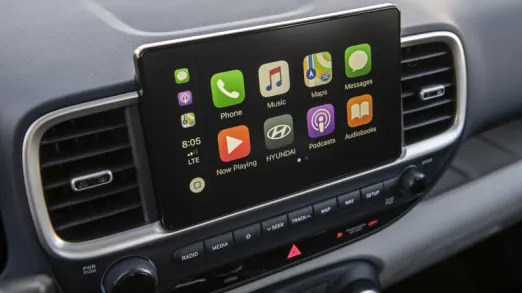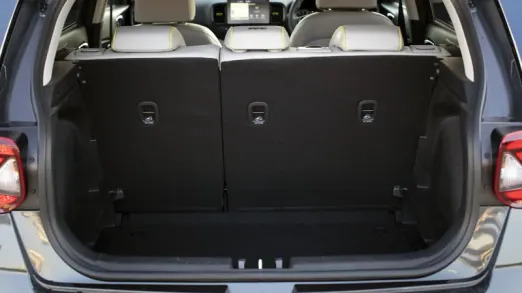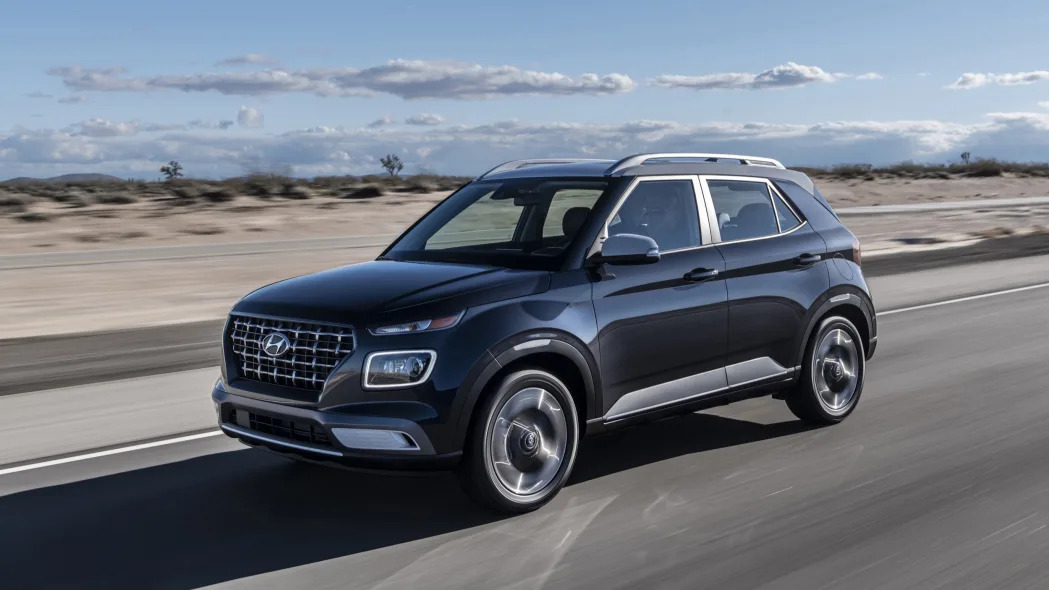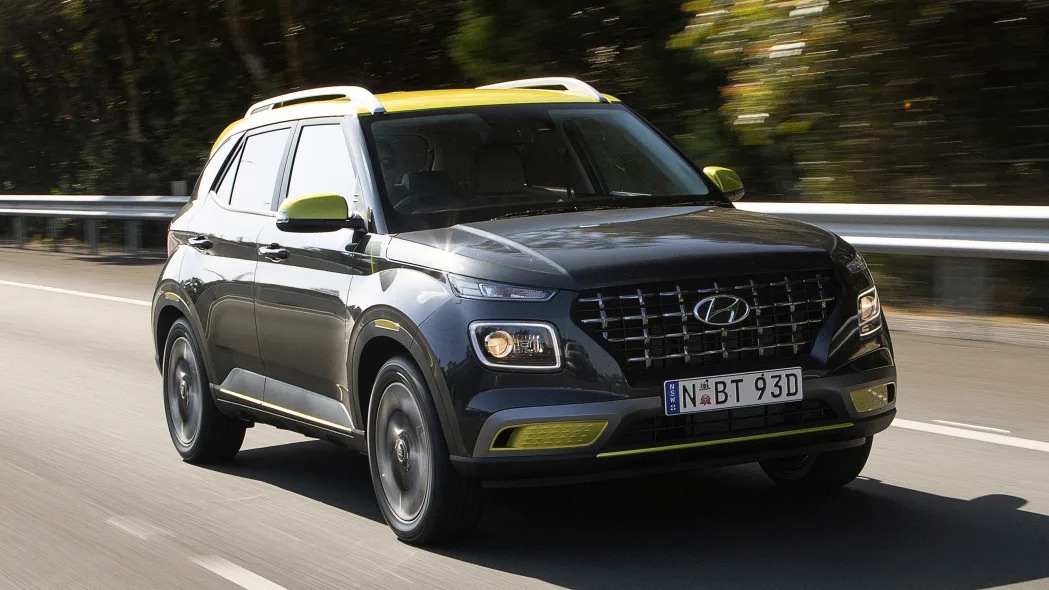The 2020 Hyundai Venue is the latest entry to the burgeoning subcompact crossover segment, but rather than targeting the heart of that crowded group, it aims for the entry point with a small size and similarly small price. The all-new model for Hyundai is highly attractive with a chiseled, upright body and wide stance. Looking closely reveals clever details such as the woven pattern to the grille and the angular taillight lenses. The interior has typical hard plastics, but controls are easy to use and the design is funky and cheerful with the Denim model going above-and-beyond with a unique blue color scheme to match its exterior. On the whole, the Venue is pleasant to drive with nippy handling and adequate acceleration from its little engine.
The most direct competitors to the Hyundai Venue are the Nissan Kicks and the Kia Soul. Both are priced closely to the Hyundai and are similarly only available with front-wheel drive. The Kicks is a bit more fuel efficient and offers more cargo space, but isn't as fun to drive. The Soul is significantly larger than both, offers more powerful engines and additional trim choices, but can also end up costing more as a result and is less efficient. Still, it's worth checking out all three along with a pair of small hatchbacks: the Honda Fit and Kia Rio. They may not have the crossover looks or modest ground clearance increase, but they have lower prices and better fuel economy. The Fit even has more total cargo space.
That hodge-podge collection of competitors aside, the Venue is nevertheless an attractive, cost-effective alternative to any of the subcompact crossover contenders so long as all-wheel drive isn't a must.
What's new for 2020?
The Hyundai Venue is a completely new model introduced this year.



What's the Venue's interior and in-car technology like?
As with most cars in this price range, the Venue’s interior has a plethora of cheap, hard plastics. Fortunately, Hyundai uses a nice mix of colors and textures that makes it look more upscale than it is. It also has nice details such as little hashmarks dotting the outside of the instrument dials, a stylish temperature and fan speed display for the automatic climate control, and nifty striped fabric in the up-level SEL we tried out. The Denim model, pictured above, goes a step further with a unique light blue interior and matching upholstery.
Also sprucing up the interior’s design is the large 8-inch infotainment display. It’s paired with Hyundai’s convenient and solid-feeling shortcut buttons and knobs, plus a simple on-screen user interface. Apple CarPlay and Android Auto are included on every Venue, while an extra USB port and two more speakers (six total) are included with the SEL and Denim.


How big is the Venue?
The Venue is a very small crossover at just 159 inches long, which is a full 10 inches shorter than its close competitor the Kicks. It's also a featherweight, tipping the scales at a little more than 2,500 pounds. This size makes it easy to maneuver, but so does the Venue's great forward and lateral visibility made possible by tall, upright windows and thin pillars. Rear visibility is marred by thick rear pillars, but isn’t any worse than the competition (in some cases, it's actually better).
Space for front passengers is accommodating, particularly with headroom. It’s also easy to find a comfortable seating position with the extra-adjustable tilt-and-telescoping steering wheel, and head- and legroom are generous up front. The seats themselves have thick, soft cushioning that makes up for limited lumbar support and bolstering. The rear seat is a bit tight when it comes to legroom. Your author is of average male height and could sit behind himself, but knees rubbed on the hard plastic back of the front seat. The seat itself also lacks much shape, but at least the angles of the seat base and back rest are comfortable.
Cargo space comes in at 18.7 cubic feet behind the rear seats, which is less than the class-leading Kicks and its 25.3 cubic feet, but consistent with the rest of the segment. Given the Venue's boxy shape, we're guessing that in practice, it may be more practical than most subcompact crossovers. With the seats folded, the Venue’s 31.9 cubic feet is nearly the same as the Nissan.
What's the Venue's performance and fuel economy?
The Hyundai Venue comes with one engine, a naturally aspirated 1.6-liter inline-four that makes a modest 121 horsepower and 113 pound-feet of torque. Buyers have the choice of a six-speed manual transmission (SE only) or a CVT that's optional on the SE and standard on the SEL and Denim. All-wheel drive is not available, so buyers will have to be fine with front-wheel drive. Fuel economy varies by transmission. Overall, the CVT is more efficient with 30 mpg city, 34 mpg highway and 32 mpg combined. The manual gets 27 mpg in town and 30 mpg combined, but highway fuel economy is slightly higher at 35 mpg.
What's the Venue like to drive?
Despite a small amount of power, the Venue has comfortable if not quick acceleration. It certainly feels peppier than the Kicks, even though they both have similar power and weight. The engine thrashes and buzzes at high rpm. The CVT works fine, but has a bit of a rubber band-response to throttle inputs. The set ratios for the manual mode make it feel sportier, and it shifts between them smoothly and promptly. We haven’t had an opportunity to try the manual version, though the Accent with the same engine and a six-speed manual has proven to have a positive shifter and good clutch feel, so we would expect similar for the manual Venue.
The Venue also strikes a good balance between ride and handling. Most bumps are smoothed out, and only large ones result in a bit of floatiness. Going over multiple successive bumps doesn’t make it feel jittery and unsettled. In corners, the Venue turns in quickly and the body doesn’t roll much. It does understeer quite a bit. The steering is weighted well and it builds up resistance with more input, but does so with an artificial springiness.
What more can I read about the Hyundai Venue?
2020 Hyundai Venue First Drive | Small, with a big heart
Our first drive of the Venue takes place in Australia, which is why some of the photos you'll see have the steering wheel on the right side of the car. We discuss in more detail its design and engineering.
What features are available and what's the Venue's price?
The base Hyundai Venue SE with a manual transmission starts at $18,470, and adding the CVT brings the price to $19,670. The Venue SE’s feature set is fairly basic as far as comfort and convenience items are concerned with power windows and locks, manual climate control, cruise control, a height-adjustable driver seat, a four-speaker sound system and an 8-inch touchscreen infotainment system with Apple CarPlay, Android Auto compatibility, one USB port and Bluetooth.
The SEL trim adds alloy wheels, chrome grille trim, roof rails, rear disc brakes, a drive mode for snow that adjusts throttle and traction control settings, a driver armrest, automatic climate control, an upgraded six-speaker sound system and an extra USB port. The top-level Denim gets an exclusive blue and white paint scheme and blue interior, larger 17-inch alloy wheels, LED headlights and taillights, heated mirrors, blind-spot warning, proximity entry and push-button start, heated front seats, a leather-wrapped steering wheel, and integrated navigation. All of these features, except the exclusive colors, are available as options on the SEL trim, as well as a sunroof that’s not available with the Denim trim. The full price list is below and a full breakdown of features, specs and local pricing for each trim can be found here on Autoblog.
- SE Manual: $18,470
- SE CVT: $19,670
- SEL: $20,370
- Denim: $23,170
What are Venue's safety equipment and crash ratings?
The Venue does not yet have crash test ratings from IIHS or NHTSA, but we can discuss the car’s safety features. All Venues come standard with forward automatic emergency braking with pedestrian detection, lane-keeping assist, automatic headlights and driver attention warning. Blind-spot monitoring and rear-cross traffic warning are available as an option on the SEL, and standard on the Denim. They are not available at all on the base SE.
Related Video:












Sign in to post
Please sign in to leave a comment.
Continue